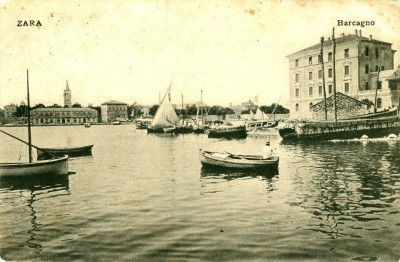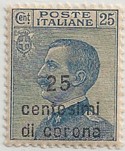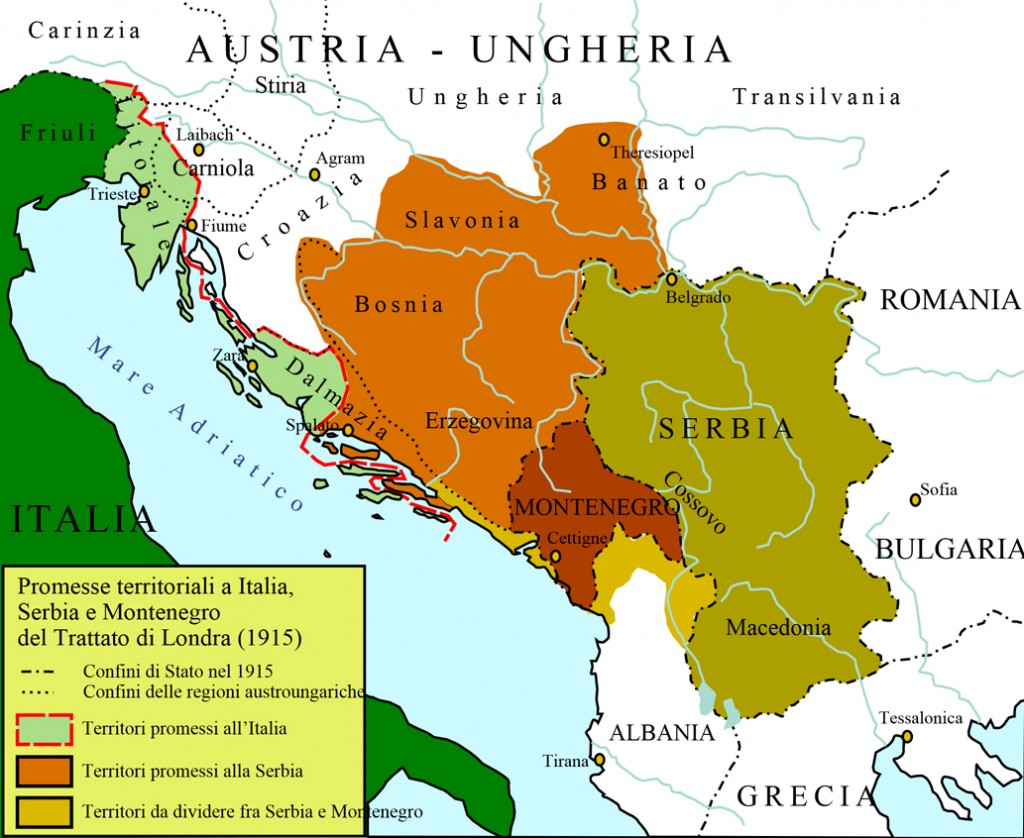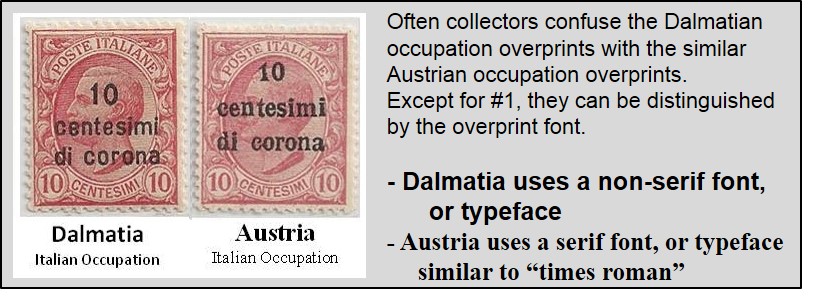ALBUM – View my Dalmatia, Italian Occupation album
Fast Facts
Region: Balkans
Group:: Italian Occupations after WW1
Classification: Occupation (Italy)
Prior Regime: Austro Hungarian Empire
Key Dates:
1915, Apr 26 – Treaty of London agreed, Italy would join WW1 on the side of the Triple Entente
1918, Nov – WW1 ends, Italy send troops to occupy Zara (Zadar) and northern Dalmatia
1919, Apr – Vittorio Orlando, Italian minister at the Paris Peace talks, leaves negotiations in anger
1919, Jun 28 – Treaty of Versailles signed, Italy is not given Dalmatia
1919, Sept 12 – Gabriele D’Annunzio takes Fiume (Rijeka) ultimately creating the Regency of Carnaro.
1920, Nov 12 – Italy signs Treaty of Rapallo, agrees to give up Dalmatia except Zara and a few islands
1924 – Italy signs Treaty of Rome which also gives Fiume (Rijeka) to Italy
Following Regime: Kingdom of the Croats, Serbs and Slovenes
Scott Catalogue: (Dalmatia) #1-8, E1-E2, J1-J4
Pick Catalogue: I am unaware whether Italy issued currency specific for the occupation
History

At the onset of World War 1, Italy was initially allied with Germany and Austria-Hungary. However, in a secret pact signed with Great Britain, France and Russia, the Kingdom of Italy agreed to join the “Triple Entente” and declare war on Austro-Hungary and Germany within a month. This pact, known as the Treaty of London, was signed on 26 April, 1915 and Italy was promised territory after the war, including northern Dalmatia, the Dodecanese Islands (which they already held), and the Austrian Littoral region which included Istria.
At the end of the war (Nov 1918), the Italians landed troops in Zara (Zadar) and began occupying regions of Dalmatia. After the war, the London pact was nullified by the Treaty of Versailles, primarily because President Woodrow Wilson of the U.S.A. did not support the Italian claims to many of the territorial expansions in the agreement. Italy was only awarded small tracts of Austrian territories, and needed to evacuate the areas it held in Dalmatia. The results of the negotiations caused the Italian negotiator at the talks, Vittorio Orlando, to storm out of the conference in anger.
Finally, the Treaty of Rapallo (November 12, 1920), agreed between Italy and the Kingdom of the Croats, Serbs and Slovenes awarded all of Dalmatia to the Yugoslavs except Zara (Zadar) and the islands of Cherso (Cres), Lussino (Lussinj) and Lagosta (Lastovo), which would remain as part of the Kingdom of Italy.
The rage and embarrassment in Italy caused great internal political upheaval, believing they fought a meaningless war with no benefit to Italy. Known as the mutilated victory (Italian: vittoria mutilata), the anger in Italy caused Gabriele D’Annunzio to take Italian troops and march into Fiume (Rijeka) on 12 Sept, 1919 to create the short lived “Regency of Carnaro”. Later in the Treaty of Rome (1924), Italy obtained the rights to Fiume. Ultimately the chaos in Italy resulted in the March on Rome in Oct, 1922 overthrowing the Italian government, and preparing the way for rise to power of Benito Mussolini and the Fascists in Italy.
Stamps
 ALBUM
ALBUM
At the end of World War 1 (Nov 1918), the Italians moved into regions of Dalmatia and Austria where they expected to be awarded at the Paris Peace talks. Beginning in 1919, stamps of Italy were surcharged in koruna (corona in Italian), which was the local currency as the regions were formerly part of the Austrian Empire. With the exception of the single 1919 surcharge in Dalmatia, the stamps of the region can be distinguished by the font of the surcharge (see diagram below). Between 1919-1922, 8 regular, 2 special delivery, and 4 postage due stamps were issued for Italian Dalmatia.
1919 Surcharge – On 1 May, 1919, Italy surcharged the Italian 1 lira definitive stamp featuring a portrait of King Victor Emmanuel III “una corona” for use in Dalmatia. Although this stamp is the only Dalmatian surcharge which is printed in serif font, it can be distinguished from the Austrian Occupation issue as it spells “una” vs the Austrian occupation stamp which uses the numeral “1“.
1921-22 Surcharges – After the Italians agreed to leave Dalmatia in the Treaty of Rapallo, Italy, in 1921-22, surcharged 7 Italian definitive stamps in corona for use in the area of Dalmatia where Italy still occupied. The stamps were surcharged in a non-serif font and all surcharges used a numeral (including the 1 corona) for the surcharge.
1921 Special Delivery Surcharge – With the definitive overprints of 1921, a single Special Delivery stamp was overprinted for use in Zara.
1922 Special Delivery Surcharge – In 1922, a Special Delivery Stamp was surcharged “LIRE 1.20 DI CORONA“, which was an error. The stamp was never issued, but some quantity was sold to the philatelic market.
1922 Postage Due Surcharges – As postal service became more routine, 4 Italian Postage Due stamps were surcharged in October 1922 for use in Zara.
Stamps of Dalmatia were no longer valid for use after 19 Jun, 1924.
Banknotes
I am unaware whether Italy issued currency specific for the occupation. If anyone has information about banknotes from this era, I would love to hear from them.
Links
Discussion of Italian claims begins at Paris peace conference – from This Day in History
Italy – 1918-1921
DALMATIA – DALMAZIA at Virgin Stamps






